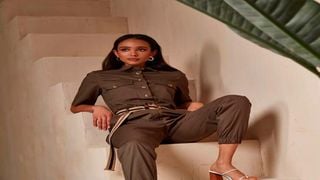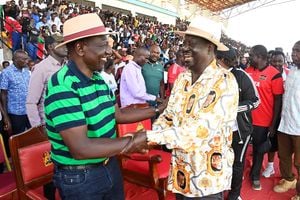
A model wears women’s Kaunda suit.
| File | Nation Media GroupNews
Premium
For the love of stylish Kaunda suit
What you need to know:
- To know the power of the Kaunda suit is to understand a political stance.
- Also known as the safari suit, it is traced back to one Don Dunstan, the former Premier of South Australia.
People love to say fashion isn’t political. So let’s take a litmus test.
A black and white picture was circulating on Twitter yesterday morning. Former Zambian President Kenneth Kaunda had just been declared dead. It captures three formidable, vibrant firebrands at their peak. They are, from left to right, Robert Mugabe, Julius Nyerere and Kaunda. They are all dressed in facsimile Kaunda suits. In this portrait of three African presidents, Kaunda gives Nyerere the side eye as he palms his trademark white handkerchief and Mugabe listens keenly.
Here we have a generation of leaders who were larger than life, with an international stickability factor and edges that continuously and repeatedly head-butted with the West. The most visceral measure of that being clothing themselves in anything but the typical suit as a portrayal of the urbane male.
I know the Kaunda suit well. My father, like a lot of Pan African men of his generation, wore it with nyadhi; a Luo word that means “great personal style”. Of course, they did not go as far as donning a white pocket square to be pulled out in a flourish to dab tears.
Some call it the safari suit. Others call it a shaket, a collapse of the words shirt and jacket. To know the power of the Kaunda suit is to understand a political stance. It first stepped out in Australia in the 1970s. To say that men in the 1970s dressed well would be a subtlety. The 70s were the era of black pride and bell-bottoms. It then figures that a black president would be an influencer, right?
It is said by many that the Kaunda suit was worn for its casual, stylish comfort under the hot equatorial sun. I believe at some point during his presidency, Kaunda made the switch to what became his style of choice. He, in the past, stated it was enterprising Kenyans who replicated this suit, and so as not to upset him, called it the Kaunda suit. He told it with mirth.

Former Zambian President Kenneth Kaunda in his signature suit.
The 1970s are marked as the moment safari suits made their way into the wardrobes of the elite. The safari suit, as a trend, carried on into the 80s and even part of the 90s. But first...
The safari suit is traced back to one Don Dunstan - the late. He was the Premier of South Australia. Don the trendsetter, apparently wore the heck out of a safari suit, because in March 1974, internet sources state, male politicians in the North got permission to wear khaki suits during assembly sittings.
The Speaker is recorded as saying, “Honourable members, I have received a further request that the standard of male dress be relaxed to include safari jackets. I have been in touch with the federal parliament and I find that the Speaker ... is allowing safari jackets with shirt and tie. He also allows one member to wear a safari jacket over an open-necked shirt. Therefore, I have decided to accept safari jackets as suitable dress in the assembly. I must say that I do this very reluctantly because I feel that we have relaxed our standards too far. However, the precedent has been set. I might add that I will not allow T-shirts.”
Perhaps it was this speech that inspired Prince Charles to wear a safari suit almost a decade later when he visited Australia with Princess Diana.
That, is, however, not the most spectacular pop culture moment the safari suit has ever enjoyed. That actually came about with the ultimate male style icon, 007 played by Roger Moore in The Man with the Golden Gun, Moonraker and Octopussy. It comes back in Timothy Dalton’s wardrobe in License to Kill. They set trends because Bond favours monochrome. Also, because men’s fashion – nay, style magazines, told them to.
The safari suit was certainly not Kaunda’s creation. He took what the colonialists wore, and replaced the shorts with pants, dropping the sola topi - the helmet that guarded against the sun – and could give or take the sleeves. The Dictionary of Fashion History says this colonial uniform was, “clothing created for cross-country expeditions, especially in East Africa.”
White handkerchief
It was the colour of nothing, really. It looked like pale sand or a green so mild it had to be khaki. The half-sleeved shirt and shorts were made from the same fabric.
The dictionary continues. “Suitable clothing for Europeans had to be both sturdy and lightweight.”
The outfit consisted of a belted jacket with a vented back, and pleated outside pockets with flaps, “not dissimilar to the Norfolk jacket.” It cites 20th century films as a backdrop to these “rugged garments that inspired fashion designers.” Made from blended polyester or worsted wool, the safari suit is certainly the only outfit that has ever challenged the suit, and won.
Even when he was bent over with age, chiding Cyril Ramaphosa, playing the piano to accompany the stunning young Miriam Makeba – clearly they knew how to throw a party – Kaunda was spotted in iterations of his Kaunda suit with a cravat-scarf wound around his neck. His white handkerchief is said to have been representative of humility.
Charles Onyango-Obbo, aptly captured its white presence in The East African. “However, I think the ultimate secret is in his white handkerchief and penchant for crying. By crying, Kaunda got rid of lots of cortisone and bad karma that other leaders bottle up, thus turning them into bitter and cruel men.”





